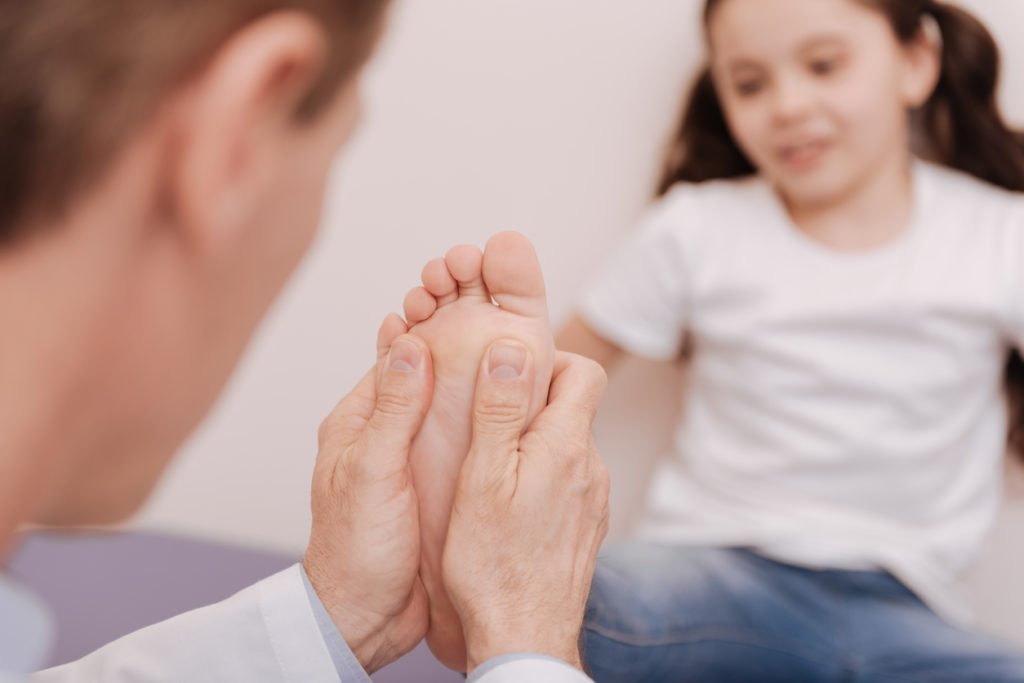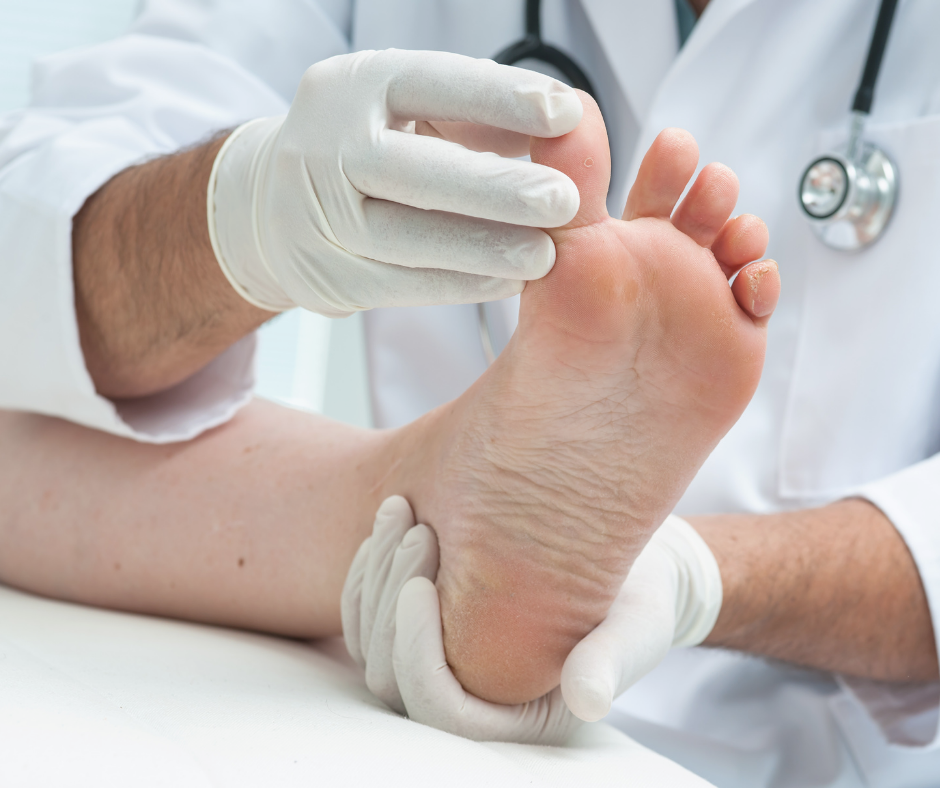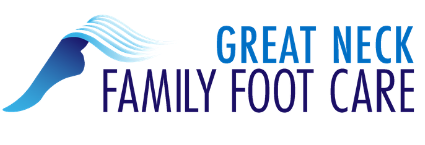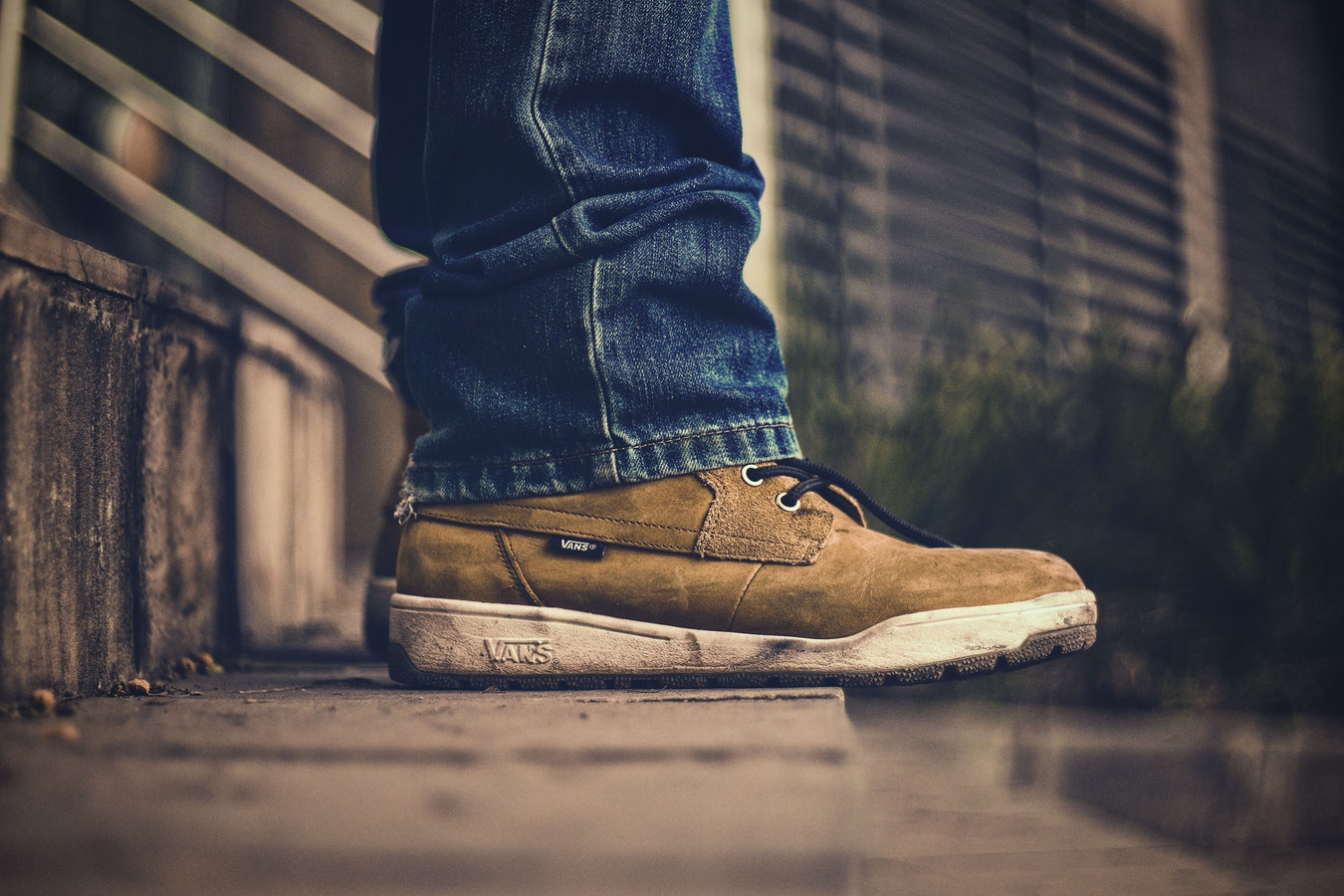
Podiatrist in Bayside, NY
What Is A Doctor of Podiatric Medicine?
A Doctor of Podiatric Medicine (DPM) is the medical specialist for the foot and ankle. Podiatrists are licensed to diagnose and treat conditions of and relating to the foot and ankle. Treatment can be medical, surgical, or biomechanical. (Biomechanics is the study of how the foot and leg function when the foot contacts the ground.) The podiatrists’ extensive knowledge of biomechanics allows them to alleviate many conditions with conservative therapy rather than surgery. However, when necessary surgically trained podiatrists have the capability to fix the most complex foot and ankle conditions. For more information on our local Podiatrist in Bayside, NY, please continue reading this informational page.
Check Out Dr. Hochstein in Action!
Education
Candidates for admission to Podiatric Medical Schools are expected to complete baccalaureate degrees before admission. As with institutions granting MD (medical doctor) and DO (doctor of osteopathy) degrees, the colleges will consider candidates who show unusual promise and have completed a minimum of 90 semester hours at accredited undergraduate colleges or universities. About 95 percent of all first-year students entering the colleges of podiatric medicine possess baccalaureate degrees, and about 10 percent have master’s degrees.
Applicants for admission are required to complete the Medical College Admission Test (MCAT) as a prerequisite. The course of instruction leading to the DPM degree is four years in length. The first two years are devoted largely to classroom instruction and laboratory work in the basic medical sciences, such as anatomy, physiology, microbiology, biochemistry, pharmacology, and pathology. During the third and fourth years, students concentrate on courses in the clinical sciences, gaining experience in college clinics, community clinics, and accredited hospitals. Clinical courses include general diagnosis (history taking, physical examination, clinical laboratory procedures, gait analysis, biomechanics, and diagnostic radiology), therapeutics (pharmacology, physical medicine, orthotics, shoes, and prosthetics, surgery, anesthesia, and operative podiatric medicine.
After completing the four-year course and receiving the DPM degree, the graduate is required to complete postdoctoral work before state licensure.
Postdoctoral and Continuing Education
As they near graduation, prospective podiatric physicians seek postdoctoral residency programs. These programs, designed to strengthen and refine the practitioner’s medical, surgical, biomechanical and /or orthopedic skills, are based in hospitals accredited by the Joint Commission on the Accreditation of Healthcare Organizations (JCAHO) and the American Osteopathic Association (AOA). These programs are at usually two or three years in length and may extend to four years.
Following residency, the podiatric physician may enter practice or continue their education through Fellowships in specialized areas of study.
Practice
Podiatric Physicians are licensed in all 50 states, the District of Columbia, and Puerto Rico to treat the foot and its related or governing structures by medical, surgical, mechanical, or other means. In addition to private practices, they serve on the staffs of hospitals and long-term care facilities, the faculties of schools of medicine and nursing, as commissioned officers in the Armed Forces and US Public Health Service, in the Department of Veterans Affairs, and in municipal health departments. Many podiatrists today are also part of group medical practices.
Special Areas of Practice
In its continuing efforts to protect and improve public health and welfare, APMA has recognized and approved two specialty boards that certify in three areas: podiatric orthopedics, podiatric surgery, and primary podiatric medicine. These boards confer certification on a podiatric practitioner who has satisfactorily passed written and oral examinations and has demonstrated knowledge and experience in his or her chosen specialty.
Those boards are the American Board of Podiatric Orthopedics and Primary Podiatric Medicine and the American Board of Podiatric Surgery.
Services
Our staff and Podiatrist in Bayside, NY at Great Neck Family Foot Care maintain a high level of experience in the diagnosis and treatment of the following foot and ankle conditions. If you are currently experiencing pain in your feet or ankles, please do not hesitate to contact our offices at (516) 482-5999 to schedule an appointment. The best path to a full recovery is early diagnosis and treatment.
Contact Us Below
House Calls Available: If you are unable to visit the office due to a debilitating injury or disability, Great Neck Family Foot Care will make accommodations in order to visit your residence for the appointment. Please notify a staff member when scheduling an appointment to arrange a house call with our specialist.
Have a question? Call us at (516) 482-5999 or fill out the form.
4 Common Podiatry Questions
When it comes to your feet and maintaining the health of them, it helps to have as much knowledge about care and treatment as possible. Whether you are suffering from some mysterious, minor discomfort in your foot or just got out of surgery, it’s normal to have plenty of questions about your condition. In this post, we will take a look at the four most commonly asked questions related to podiatry and provide you with the answers.
How Can I be Sure my Feet Are Getting Proper Blood Flow?
If you have a circulation concern about your feet, a podiatrist will be able to check the pulse in your feet the same way you check for a pulse in your wrist. If your pulse is weak, it often means poor circulation. Other indicators that you are not getting good blood flow include thinning hair, skin discoloration and extra shininess in the skin, and brittle nails. You might also start to experience cramping in your legs if you are suffering from poor circulation to your feet. If you notice any of these symptoms, it is important to contact a podiatry specialist to get a complete examination.
Am I Suffering From a Stress Fracture in my Foot?
Stress fractures are quite common and need to be treated the same way regular fractures are treated: with four to six weeks of rest. If you experience swelling, redness, or bruising, in your foot, these could be signs of a stress fracture. If after resting, elevating, compressing, and icing your foot, these signs still persist, it is a good indication that you could have a stress fracture in your foot. If this is the case, you will need to call a podiatry center to schedule some emergency x-rays and stay off of your foot until you know whether or not you have a fracture.
What do I Need to do if I Have a Broken Toe?
Essentially everyone at some point in their lives will experience the unfortunate displeasure of walking into something and stubbing their toe. In most cases, although it is painful, it doesn’t become a serious injury. However, once in a while, a stubbed toe or other toe injury results in a break. If you suspect you have a broken toe, the best thing to do is get it examined by a podiatry specialist. From there, they will put your toe in a splint, aligning it with the toe next to it. It can take anywhere from four to eight weeks for your toe to fully recovery. In that time, you may be able to start wearing regular shoes again, otherwise, you may need to wear a hard bottomed, open-toed shoe provided to you by your podiatry specialist.
How Can I Avoid Bunion Surgery?
Fortunately, for individuals suffering from a bunion, surgery is typically a last resort. It is only used after other treatments are tried. If the bunion is a severe problem, only then will surgery be necessary. In most cases, when the bunion is caught early on and treated right away, it doesn’t turn into a long-term, painful, and expensive problem. If you notice you have a bunion, call a podiatrist to get early treatment and avoid bunion surgery altogether.
Podiatrist in Bayside
Do you have a podiatry related question that you don’t see included above? Don’t hesitate to contact our Podiatrist in Bayside, NY today. We are eager to answer anyone’s questions about their foot needs. Whether you are suffering from a painful fungal toenail infection, suspect that you have broken a bone, or have any other foot condition that is bothering you, don’t hesitate to reach out to us.
What is Jackson-Weiss Syndrome?
Jackson-Weiss Syndrome is a rare genetic disorder affecting a child’s head, facial area, and feet. The characteristics that occur include malformation in all three previously mentioned areas. It is caused by a genetic mutation within the FGFR2 gene. Characteristics of the affected areas usually occur in the head or feet. The foot abnormalities tend to be the most common with Jackson Weiss Syndrome. Those diagnosed with this disorder have a normal life span, and the syndrome is also equally diagnosed among males and females. If you or someone you know is suffering from Jackson-Weiss Syndrome, know there is a Podiatrist in Bayside, NY that can help!

Common Symptoms of Jackson-Weiss Syndrome:
Someone who is suffering from Jackson Weiss Syndrome will likely recognize the following symptoms:
- Widely shaped skull
- Misshapen eyes
- The flat, underdeveloped middle area of the face (midface hypoplasia)
- Distinct Foot Abnormalities
- Short and wide big toes
- Abnormally shaped toes
- The big toe bends away from other toes
Jackson-Weiss syndrome is diagnosed at birth based on the defects present at the time. It is also typically followed up by genetic testing if the initial diagnosis doesn’t give clear confirmation.
How do you treat Jackson-Weiss Syndrome?
Unfortunately, there is not one singular treatment for this syndrome. Treatment can vary depending on the specific symptoms each patient experiences. Typically, surgery is used as a treatment when it comes to lessening or correcting birth defects caused by this syndrome. When it comes to the feet, a Podiatrist in Bayside, NY will likely perform cosmetic surgery in an effort to eliminate any abnormalities that appeared. In some cases where mobility is affected, it may be beneficial to seek out therapy. This may include physical therapy or any other orthopedic support. Seeking out a treatment method sooner rather than later will only allow your child to reach their full potential.
If you are dealing with foot abnormalities due to Jackson-Weiss Syndrome, Dr. Alec Hochstein is a Podiatrist in Bayside, NY who provides a wide range of cosmetic foot care as well as surgery. Make an appointment with Great Neck Family Foot Care to help any pain, discomfort, or abnormalities due to Jackson-Weiss Syndrome today!
Diabetic Foot Problems
Diabetes is a disease affects multiple organs in the body. It affects a patient’s immune system, nervous system, and the circulatory system just to name a few. In a controlled diabetic patient, the effects of diabetes are usually well controlled. When complications of the disease occur, often the feet are the first to be affected. Long Island Diabetic patients are strongly advised to have a routine foot exam with our podiatrist in Bayside, NY twice a year. This will prevent any foot problems that are so often associated with diabetes. A routine diabetic foot exam includes testing for blood flow, nerve function, skin condition, and joint function.
Diabetes can affect the circulation and cause decreased arterial blood flow to the feet. With decreased oxygen getting to the small vessels in the feet and toes, the skin loses hair and becomes less pliable, and often has a dry, thin appearance. If the patient with decreased circulation develops a wound, it is much less likely to heal and can become infected. A routine foot exam assesses the amount of blood flow to the feet and non-invasive testing such as ultrasound can be preventative.

Diabetes can affect nerve function. Many times, one of the first symptoms of diabetes is the loss of sensation in the feet (neuropathy). Patients can step on something sharp and not feel it, which can lead to infection and several other complications. Nerve function can easily be tested by our podiatrist in Bayside, NY non-invasively.
Part of the diabetic foot exam includes close inspection of the skin of the feet and in between the toes. The skin is examined for calluses caused by increased pressure to an area, bruising, blisters, dry skin and an opening in the skin. Preventative measures including proper shoe gear and daily moisturizing of the skin will prevent complications. The skin exam also includes an exam and treatment of the toenails. The nails can become thickened and brittle with diabetes and become difficult to care for at home. Our podiatrist in Bayside, NY can properly care for the nails and recommend proper moisturizing products and shoe gear.
Lastly, the diabetic foot is inspected for bone and joint abnormalities. Bony deformities such as bunion and hammertoe deformities or any other joint contracture can be caused by an increased area of pressure on the skin. This combined with a compromised immune system, poor circulation and/or neuropathy can cause a skin ulcer, an infection which often leads to gangrene or worse, amputation.
To avoid diabetic foot complications, every diabetic controlled or uncontrolled should see our podiatrist in Bayside, NY at Great Neck Family Foot Care least once a year for a comprehensive diabetic foot exam. This will save both money and headache for the patient and guarantee good foot health despite having diabetes.
frequently asked questions
What is a podiatrist? A podiatrist is a Doctor of Pediatric Medicine (DPM) and a surgeon. He is a specialist, who limits his practice to treating conditions that affect the feet, ankles, and legs. Podiatrists treat patients of all ages from children to the geriatric. Long Island Podiatrists treat all conditions of the foot and ankle, including deformities, infections, fracture, sports injuries, skin and nail problems.
What kind of training do podiatrists have? Podiatrists must earn a Bachelor of Science degree, a Doctor of Podiatric Medicine degree (DPM), and serve a three-year residency. There are only 9 podiatric colleges in the U.S. They offer courses in anatomy, physiology, patient care, clinical practice, and podiatric medical care, generally in a four-year program. You will want to check out the training of any podiatrist who lands on your list. It is important to seek out a podiatrist who is board certified in his or her specialty.
Is that it? Isn’t there some sort of board review? Podiatrists must have a state license to practice but the requirements vary from state to state. Generally, podiatrists have to take a state licensing examination or receive a Board Certification from the American Board of Podiatric Orthopedics and Primary Podiatric Medicine.
Are podiatrists allowed to practice in hospitals? Yes, Board Certified podiatrists qualify to perform surgery on bones, joints, muscles, ligaments, and tendons of the foot, ankle and lower leg.
If you think you may need surgery, you will want to check that the podiatrist under consideration is on staff at a hospital convenient to you and that your insurance will cover the costs of your treatment. The Podiatrists at Great Neck Family Foot Care are Board Certified by the American Board of Foot and Ankle Surgeons.
I see that some podiatrists teach at hospitals? Is this important? Yes, it is. A doctor who has teaching privileges at major hospitals is undoubtedly abreast of the latest developments in his field. He will understand the latest technologies, like laser therapy for nail fungus, the latest treatments for hammer toe, and important advances in wound care, especially important to Diabetes sufferers. You want — and your feet deserve — the latest treatments. Choose a Podiatrist in Bayside, NY that can deliver them to you.
How important is the number of years of experience that a doctor has? The number of years of practice that any medical doctor has is a very important factor to consider. That holds true for podiatrists as well. You want someone who has honed his diagnostic skills by seeing many types of foot and ankle conditions and has had opportunities to use the latest technology.
Contact Our Podiatrist in Bayside, NY
To talk more about this topic, or anything else, please contact our podiatrist in Bayside, NY. For more than 17 years, Dr. Alec Hochstein and our staff at Great Neck Family Foot Care have provided our patients the best in podiatric care, including Dr. Hochstein’s advanced training in surgery and wound care. We are proud that we are part of the Great Neck, Long Island, and the New York Metropolitan community. We want to care for you, and your family.
What is Mallet Toe?
Mallet toe is diagnosed when the joint at the end on your toe buckles. This is most common with your second toe because it’s the longest, and it is considered to be unbelievably painful. There are two different types of mallet toe, flexible and rigid. Flexible mallet toe is when it’s in the developmental stage and all the joints are moveable in the toe. Rigid mallet toe can be emblematic because the tendons and joints become tight and begin to misalign. If you think you suffer from mallet toe, then visit Great Neck Family Foot Care. Our Podiatrist in Bayside, NY will make your feet as healthy as can be!
Risk Factors:
There can be various risks that come along with mallet toe. It is important that you are able to identify them; they may include:
- Age – Likeliness increases with age.
- Sex – More likely if you are a woman.
- Toe Length – High risk if your second toe is longer than your bigger toe.
- Certain Diseases – Arthritis and diabetes.
Causes:
Now that we are aware of the risks that come along with mallet toe, let’s learn what can actually cause it:
- Certain Shoes – Heels and tight shoes are more likely to cause mallet toe.
- Trauma – Past injuries to toes can provoke mallet toe.
- Abnormal Balance – Imbalance leads to instability.
To help avoid all of the risk factors and causes, you should contact our Podiatrist in Bayside, NY!
Treatment:
When it comes to treating mallet toe, there are a few things you can do. To start, you can make a few simple changes in your everyday routine, such as:
- Wearing roomier, more flexible shoes.
- Using Orthotics.
- Exercises that can help stretch as well as strengthen your toe muscles.
If these methods are proving to be ineffective, it is likely that a Podiatrist in Bayside, NY will suggest surgery. The surgery will consist of releasing the tendon that had prevented your toe from lying flat. Another scenario may include your podiatrist removing a piece of your bone in order to straighten out your toe.
Contact Us
If you are suffering from mallet toe and are ready to take the next step towards treating your condition, book an appointment with Great Neck Family Foot Care! Our Podiatrist in Bayside, NY will take great care of you, and will help ensure that you are back on your feet in no time!
Child Foot Care Help
If there’s one thing all parents can agree on, it’s that the only thing worse than enduring painful heel or ankle pain themselves is seeing their own child have to endure similar foot pain. If you are the parent of an athlete or just a child who is generally very active, it is quite likely that at some point in their childhood they’ll end up with some sort of children’s foot problem, whether that is a twisted ankle, fractured heel, or something else.
If you are currently dealing with a children’s foot problem, here are a few ways that you can help your child soothe and alleviate that pain:
1) A Compression Sleeve:
So long as your child’s ankle or heel pain isn’t so bad that they can’t even walk on their foot, consider dressing the foot in a compression sleeve. By wearing this during the day when they are walking, it will reduce swelling, inflammation, and irritation, and make it easier for them to walk correctly with less pain.
Even though a compression sleeve could be a great solution, it is still important to ensure that your child properly rests their foot whenever possible so that the recovery process can be expedited and they don’t cause the foot to experience further injury.
2) An Epsom Salt Soak:
One way to reduce the swelling in a children’s foot problem is to submerge the foot in a warm Epsom salt bath.
Get a tub and combine Epsom salt with warm water. Allow your child to soak their injured foot in the salt water for approximately 20 minutes. By doing this, not only will the experience lessen swelling in their foot, but it will also soothe the injured area and alleviate some of the pain. You can do this a couple times a day until the problem seems to subside.
Of course, if your child is suffering from a more serious ankle or heel injury or the salt water doesn’t seem to be helping, you should take your child to our podiatrist in Bayside, NY to receive proper treatment.
3) Gentle Stretches and Exercises:
Whether your child is suffering from minor pain due to overuse of their foot or they are recovering from an ankle or heel surgery, gentle stretches and light exercises make the recovery process go by even faster. So long as you have gotten the green light from the doctor, try a few stretches and exercises at home.
If you don’t feel comfortable letting your child do the exercises on their own or if their recovery demands more serious treatment, ask your doctor about the possibility of working with a physical therapist. This way, you can ensure your child is getting the treatment they need without damaging their foot with incorrect exercises.
4) Hot and Cold Therapy:
Hot therapy and cold therapy have both been tried-and-true remedies for decades, so they are definitely worth trying in order to help your child deal with their children’s foot problem. If you have access to a heating pad, instruct your child to elevate and rest their foot and compress the heating pad to the affected area. In addition to heat therapy, allow your child to ice the injured area for 15-20 minutes at a time before removing the ice for a few minutes and repeating the process. Both of these methods will soothe the area, alleviate pain, and reduce swelling.
If you are looking for more information on how to relieve heel and ankle pain or if you have a concern about a foot-related injury, please don’t hesitate to contact our podiatrist in Bayside, NY today. We are committed to helping men, women, and children get the proper treatment they need for foot injuries and other foot conditions.
Heel Pain Treatment From Local Podiatrist in Bayside, NY
Heel pain is nothing to take lightly. When your feet hurt, it can affect nearly every part of your day–from walking to your car to standing at work. You may have heard of plantar fasciitis, and you’re likely wondering if this condition is the source of your foot pain. Here’s what you need to know about plantar fasciitis, and what to do if you suspect you have it.
What is Plantar Fasciitis, Exactly?
Plantar fasciitis is a type of pain in the bottom of your heel caused by inflammation. Besides bones, the inside of your feet is also home to muscles, ligaments, and tendons. Ligaments are made of tissue, and their purpose is to connect bone to other bones. A ligament called the plantar fascia gives plantar fasciitis its name. This ligament is the longest in your foot, running along the bottom of your foot from your heel bone to your toes. When the part of this ligament near your heel becomes inflamed, it can be extremely painful for you.
What Causes Plantar Fasciitis Heel Pain?
Plantar fasciitis is sometimes called an “overuse injury.” This is because the condition occurs when patients put stress on their plantar fascia ligament by stretching or tearing it. This can happen many ways, including running, jumping, and wearing high-heeled shoes. People whose jobs involve standing and walking for long periods of time may cause stress to their plantar fascia, resulting in plantar fasciitis.
Plantar fasciitis is very common–an estimated one in 10 adults will have to deal with it in their lifetime. Some people are more likely to get the condition than others. People with either flat feet or high arches are likely to have heel pain at some point in their lifetime. Women also tend to have this type of heel pain more often than men. People who are overweight or obese add additional stress to their feet, making plantar fasciitis more likely. Runners are also more susceptible to the condition.
Plantar Fasciitis Symptoms
According to the American Academy of Orthopedic Surgeons, plantar fasciitis is the most common cause of heel pain. If you’re experiencing pain on the bottom of your foot near your heel, plantar fasciitis is likely the cause. Most people experience this pain when stepping out of bed in the morning. After walking for a few minutes, the pain begins to go away. Plantar fasciitis can also cause pain after–but not usually during–exercise.
Treatments for Your Heel Pain
If you are experiencing foot pain, it’s important to get checked out by our podiatrist in Bayside, NY. Our doctor will thoroughly examine your feet and recommend a course of action specific to your condition. Some of the most common treatments for heel pain include:
- Home Care. Some simple, noninvasive treatments can help alleviate the pain of plantar fasciitis. To take care of your feet at home, try to rest in a seated or lying down position whenever possible. You can also take over-the-counter anti-inflammatory pain relievers, such as ibuprofen and aspirin. Applying an ice pack to your heel area several times a day can also help to decrease inflammation.
- Orthotics. In order to decrease the stress on your plantar fascia, your doctor may prescribe orthotics. These are custom inserts for your shoes that support your arch and foot ligaments.
- Stretches. Stretching out your feet as soon as you wake up can help to lessen your heel pain. Your doctor can show you what to do and advise you on how often you should stretch your feet.
- Steroid Injections. In some cases, home care, orthotics, and stretching are not enough to stop heel pain. Doctors sometimes use steroid injections to lessen inflammation.
- Surgery. Most patients with plantar fasciitis will not need surgery. Surgery is not considered by most doctors until at least a year of other treatments. However, surgery is an option for some severe cases of plantar fasciitis pain.
If you suspect you have plantar fasciitis, it’s important to visit your doctor for an examination. Contact us today at Great Neck Family Foot Care to make an appointment with our caring podiatrist in Bayside, NY.
Bunion Pain Treated By Podiatrist in Bayside, NY
Are you suffering from a mysterious, chronic case of heel pain that seems to plague you every time you walk and even when you’re resting? There’s no reason to live with the pain and discomfort when there are plenty of solutions to remedy the issue with your heel, even if you can’t figure out what is causing it. If you can’t understand why you are experiencing the pain and have thought of multiple solutions that don’t seem to work, scheduling an appointment with a podiatry specialist is your best option. However, if you are still trying to figure out what is causing your mysterious heel pain on your own, here are three could-be culprits.
Improper Footwear: 
Let’s get the most common and usually least severe case out of the way right off the bat. In many instances, people experience heel pain when they walk long distances in bad footwear. If you can’t think of any recent injury that could be causing the pain, try switching your footwear, especially if you typically wear shoes with very little or no support or are used to wearing uncomfortable high heels regularly. Simply by spending less time in improper footwear, you can experience fast relief.
Stress Fracture:
Another common cause behind heel pain is the infamous stress fracture, known to plague everyone from young children to agile athletes to the elderly. A stress fracture is a very common occurrence in anyone who has decided to hit the gym for an intense workout session or go for a long-distance run when they haven’t been physically active in a while. If you overdo your workout immediately, especially when you’re a bit out of shape, you are dramatically increasing your risk of developing a stress fracture, thus experiencing pain in your heel and other parts of the leg and foot. If you continue to put pressure on the foot that you have a stress fracture in, there is a high likelihood that you’ll end up with a larger and more severe crack in the bone. The best thing to do if you think you have a stress fracture is to visit a doctor. They will be able to provide you with a proper diagnosis and tell you what needs to be done to heal the bone correctly and completely.
Achilles Tendonitis:
In your leg, you contain the largest tendon in your entire body: the Achilles tendon. This tendon connects your calf to your heel bone and when it has been overworked or worn out, you’ll experience inflammation. Anyone who does lots of jogging, endurance running, and other excessive cardio workouts without resting and stretching is susceptible to Achilles tendonitis. The best thing to do for a case of Achilles tendonitis is to properly stretch and gently exercise the calf muscle. Effective exercises include calf raises and a towel stretch. Do a few rounds of calf raises on the injured foot and finish off by stretching the calf with a towel. Simply wrap the towel around the foot and pull it toward you, getting an active stretch in the calf and the heel. Lastly, massaging the worn tendon and the rest of the calf will help reduce pain and inflammation. You can do this by gently rubbing the area yourself or seeing a massage therapist. In severe cases of Achilles tendonitis or in the case that there is a complete tear, you will need to see a podiatry specialist to be properly treated.
Contact Expert Podiatrist in Bayside
Looking for more information to help you get rid of mysterious heel pain? Or are you suffering from another foot-related ailment? Don’t hesitate to contact us with any questions you might have. We are happy to discuss our full list of podiatry services.
Patient Testimonials







